CHEVROLET OPTRA 5 2007 1.G Owners Manual
Manufacturer: CHEVROLET, Model Year: 2007, Model line: OPTRA 5, Model: CHEVROLET OPTRA 5 2007 1.GPages: 422, PDF Size: 2.39 MB
Page 111 of 422
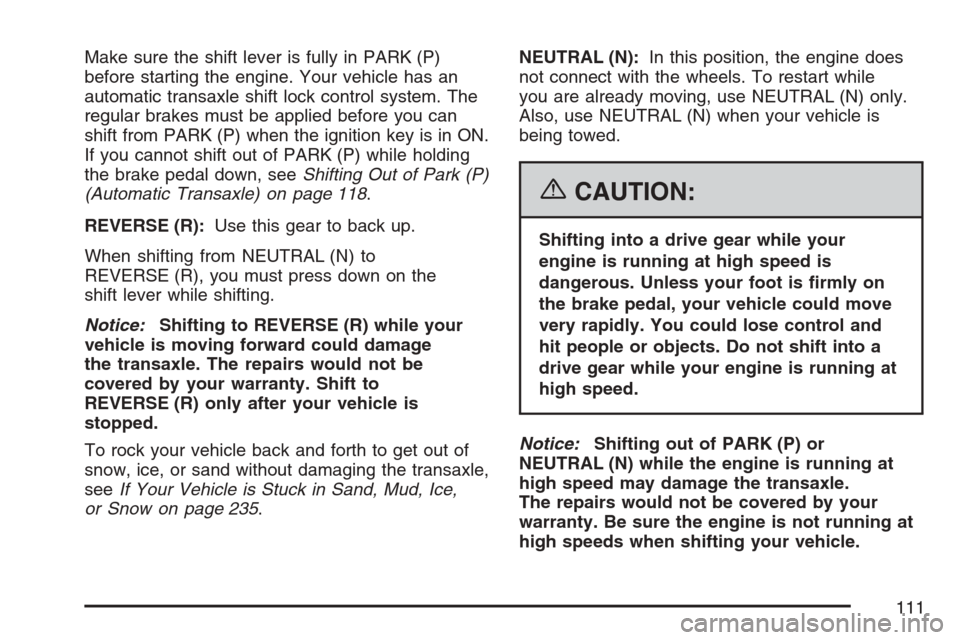
Make sure the shift lever is fully in PARK (P)
before starting the engine. Your vehicle has an
automatic transaxle shift lock control system. The
regular brakes must be applied before you can
shift from PARK (P) when the ignition key is in ON.
If you cannot shift out of PARK (P) while holding
the brake pedal down, seeShifting Out of Park (P)
(Automatic Transaxle) on page 118.
REVERSE (R):Use this gear to back up.
When shifting from NEUTRAL (N) to
REVERSE (R), you must press down on the
shift lever while shifting.
Notice:Shifting to REVERSE (R) while your
vehicle is moving forward could damage
the transaxle. The repairs would not be
covered by your warranty. Shift to
REVERSE (R) only after your vehicle is
stopped.
To rock your vehicle back and forth to get out of
snow, ice, or sand without damaging the transaxle,
seeIf Your Vehicle is Stuck in Sand, Mud, Ice,
or Snow on page 235.NEUTRAL (N):In this position, the engine does
not connect with the wheels. To restart while
you are already moving, use NEUTRAL (N) only.
Also, use NEUTRAL (N) when your vehicle is
being towed.
{CAUTION:
Shifting into a drive gear while your
engine is running at high speed is
dangerous. Unless your foot is �rmly on
the brake pedal, your vehicle could move
very rapidly. You could lose control and
hit people or objects. Do not shift into a
drive gear while your engine is running at
high speed.
Notice:Shifting out of PARK (P) or
NEUTRAL (N) while the engine is running at
high speed may damage the transaxle.
The repairs would not be covered by your
warranty. Be sure the engine is not running at
high speeds when shifting your vehicle.
111
Page 112 of 422
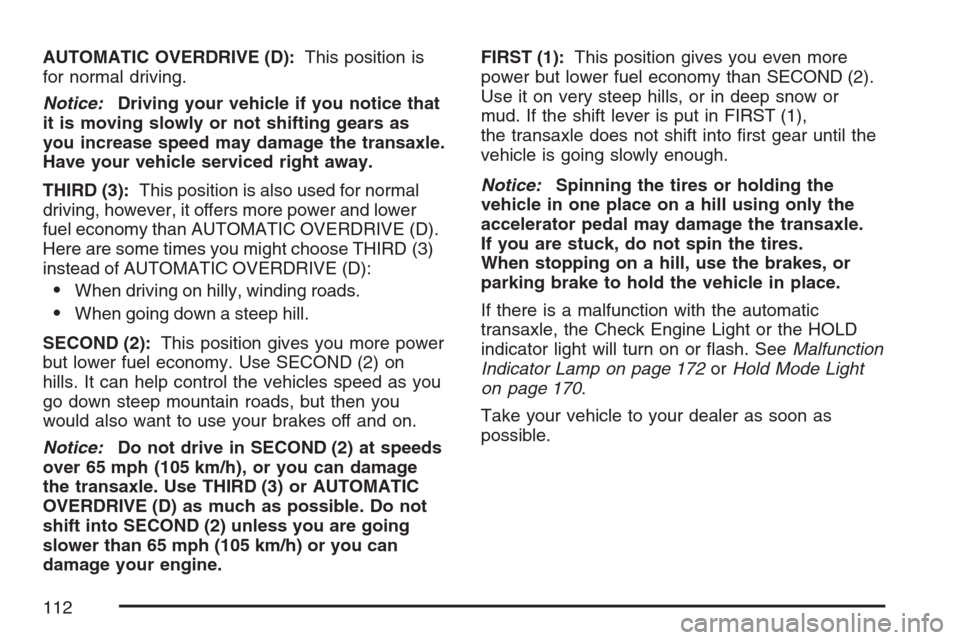
AUTOMATIC OVERDRIVE (D):This position is
for normal driving.
Notice:Driving your vehicle if you notice that
it is moving slowly or not shifting gears as
you increase speed may damage the transaxle.
Have your vehicle serviced right away.
THIRD (3):This position is also used for normal
driving, however, it offers more power and lower
fuel economy than AUTOMATIC OVERDRIVE (D).
Here are some times you might choose THIRD (3)
instead of AUTOMATIC OVERDRIVE (D):
•When driving on hilly, winding roads.
•When going down a steep hill.
SECOND (2):This position gives you more power
but lower fuel economy. Use SECOND (2) on
hills. It can help control the vehicles speed as you
go down steep mountain roads, but then you
would also want to use your brakes off and on.
Notice:Do not drive in SECOND (2) at speeds
over 65 mph (105 km/h), or you can damage
the transaxle. Use THIRD (3) or AUTOMATIC
OVERDRIVE (D) as much as possible. Do not
shift into SECOND (2) unless you are going
slower than 65 mph (105 km/h) or you can
damage your engine.FIRST (1):This position gives you even more
power but lower fuel economy than SECOND (2).
Use it on very steep hills, or in deep snow or
mud. If the shift lever is put in FIRST (1),
the transaxle does not shift into first gear until the
vehicle is going slowly enough.
Notice:Spinning the tires or holding the
vehicle in one place on a hill using only the
accelerator pedal may damage the transaxle.
If you are stuck, do not spin the tires.
When stopping on a hill, use the brakes, or
parking brake to hold the vehicle in place.
If there is a malfunction with the automatic
transaxle, the Check Engine Light or the HOLD
indicator light will turn on or flash. SeeMalfunction
Indicator Lamp on page 172orHold Mode Light
on page 170.
Take your vehicle to your dealer as soon as
possible.
112
Page 113 of 422
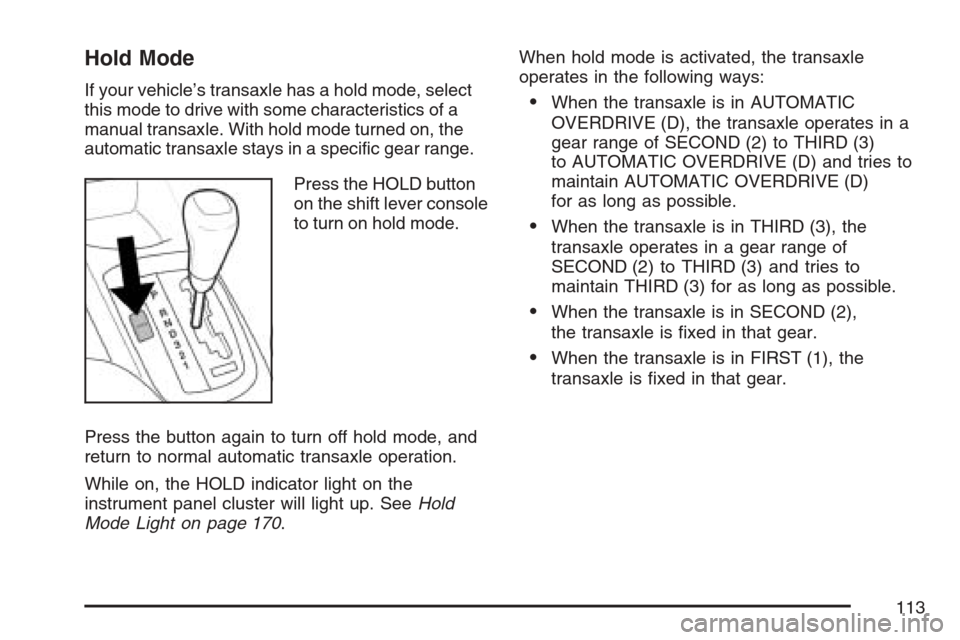
Hold Mode
If your vehicle’s transaxle has a hold mode, select
this mode to drive with some characteristics of a
manual transaxle. With hold mode turned on, the
automatic transaxle stays in a specific gear range.
Press the HOLD button
on the shift lever console
to turn on hold mode.
Press the button again to turn off hold mode, and
return to normal automatic transaxle operation.
While on, the HOLD indicator light on the
instrument panel cluster will light up. SeeHold
Mode Light on page 170.When hold mode is activated, the transaxle
operates in the following ways:•When the transaxle is in AUTOMATIC
OVERDRIVE (D), the transaxle operates in a
gear range of SECOND (2) to THIRD (3)
to AUTOMATIC OVERDRIVE (D) and tries to
maintain AUTOMATIC OVERDRIVE (D)
for as long as possible.
•When the transaxle is in THIRD (3), the
transaxle operates in a gear range of
SECOND (2) to THIRD (3) and tries to
maintain THIRD (3) for as long as possible.
•When the transaxle is in SECOND (2),
the transaxle is fixed in that gear.
•When the transaxle is in FIRST (1), the
transaxle is fixed in that gear.
113
Page 114 of 422
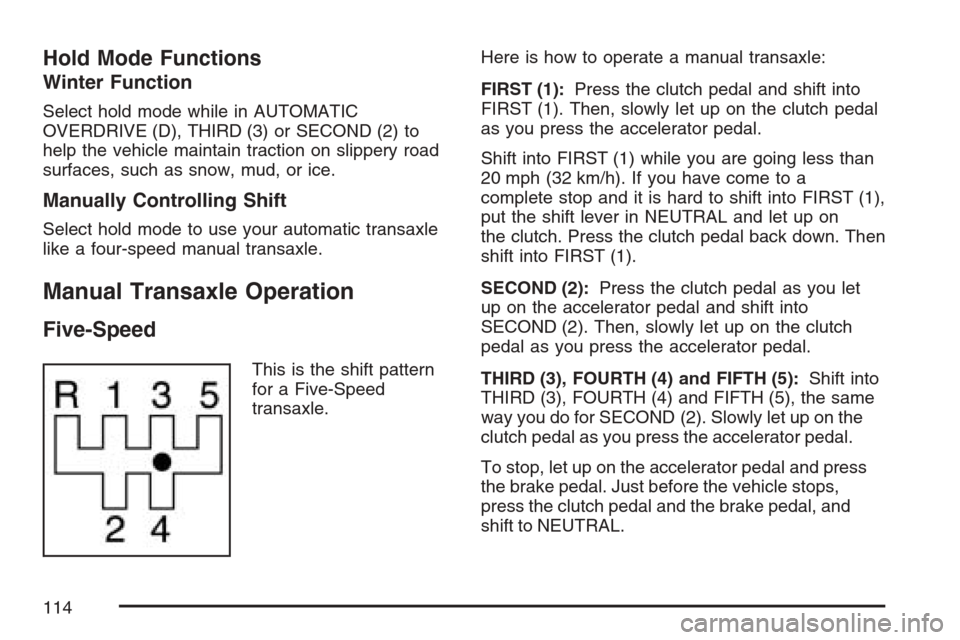
Hold Mode Functions
Winter Function
Select hold mode while in AUTOMATIC
OVERDRIVE (D), THIRD (3) or SECOND (2) to
help the vehicle maintain traction on slippery road
surfaces, such as snow, mud, or ice.
Manually Controlling Shift
Select hold mode to use your automatic transaxle
like a four-speed manual transaxle.
Manual Transaxle Operation
Five-Speed
This is the shift pattern
for a Five-Speed
transaxle.Here is how to operate a manual transaxle:
FIRST (1):Press the clutch pedal and shift into
FIRST (1). Then, slowly let up on the clutch pedal
as you press the accelerator pedal.
Shift into FIRST (1) while you are going less than
20 mph (32 km/h). If you have come to a
complete stop and it is hard to shift into FIRST (1),
put the shift lever in NEUTRAL and let up on
the clutch. Press the clutch pedal back down. Then
shift into FIRST (1).
SECOND (2):Press the clutch pedal as you let
up on the accelerator pedal and shift into
SECOND (2). Then, slowly let up on the clutch
pedal as you press the accelerator pedal.
THIRD (3), FOURTH (4) and FIFTH (5):Shift into
THIRD (3), FOURTH (4) and FIFTH (5), the same
way you do for SECOND (2). Slowly let up on the
clutch pedal as you press the accelerator pedal.
To stop, let up on the accelerator pedal and press
the brake pedal. Just before the vehicle stops,
press the clutch pedal and the brake pedal, and
shift to NEUTRAL.
114
Page 115 of 422
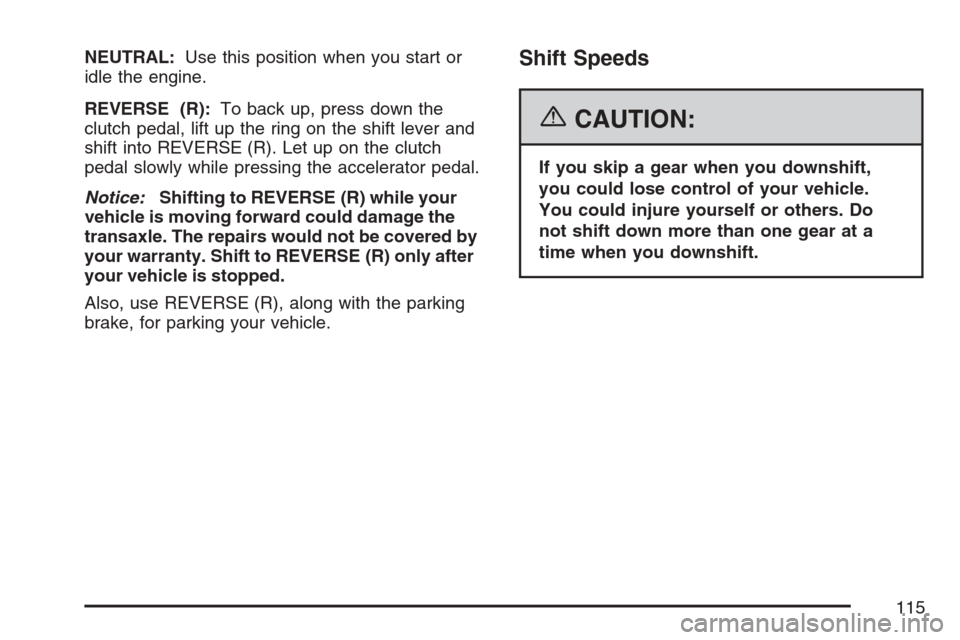
NEUTRAL:Use this position when you start or
idle the engine.
REVERSE (R):To back up, press down the
clutch pedal, lift up the ring on the shift lever and
shift into REVERSE (R). Let up on the clutch
pedal slowly while pressing the accelerator pedal.
Notice:Shifting to REVERSE (R) while your
vehicle is moving forward could damage the
transaxle. The repairs would not be covered by
your warranty. Shift to REVERSE (R) only after
your vehicle is stopped.
Also, use REVERSE (R), along with the parking
brake, for parking your vehicle.Shift Speeds
{CAUTION:
If you skip a gear when you downshift,
you could lose control of your vehicle.
You could injure yourself or others. Do
not shift down more than one gear at a
time when you downshift.
115
Page 116 of 422
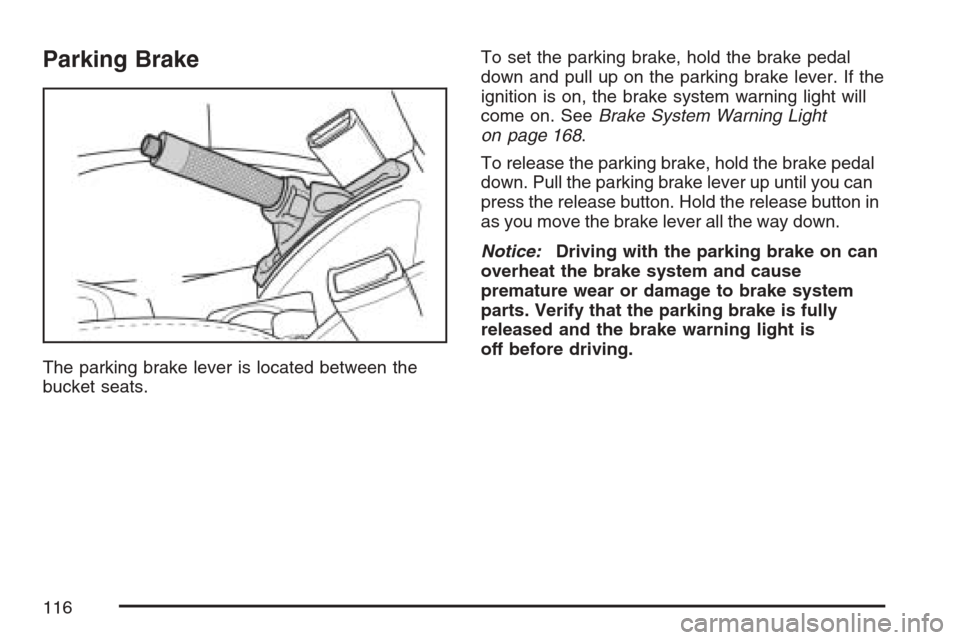
Parking Brake
The parking brake lever is located between the
bucket seats.To set the parking brake, hold the brake pedal
down and pull up on the parking brake lever. If the
ignition is on, the brake system warning light will
come on. SeeBrake System Warning Light
on page 168.
To release the parking brake, hold the brake pedal
down. Pull the parking brake lever up until you can
press the release button. Hold the release button in
as you move the brake lever all the way down.
Notice:Driving with the parking brake on can
overheat the brake system and cause
premature wear or damage to brake system
parts. Verify that the parking brake is fully
released and the brake warning light is
off before driving.
116
Page 117 of 422
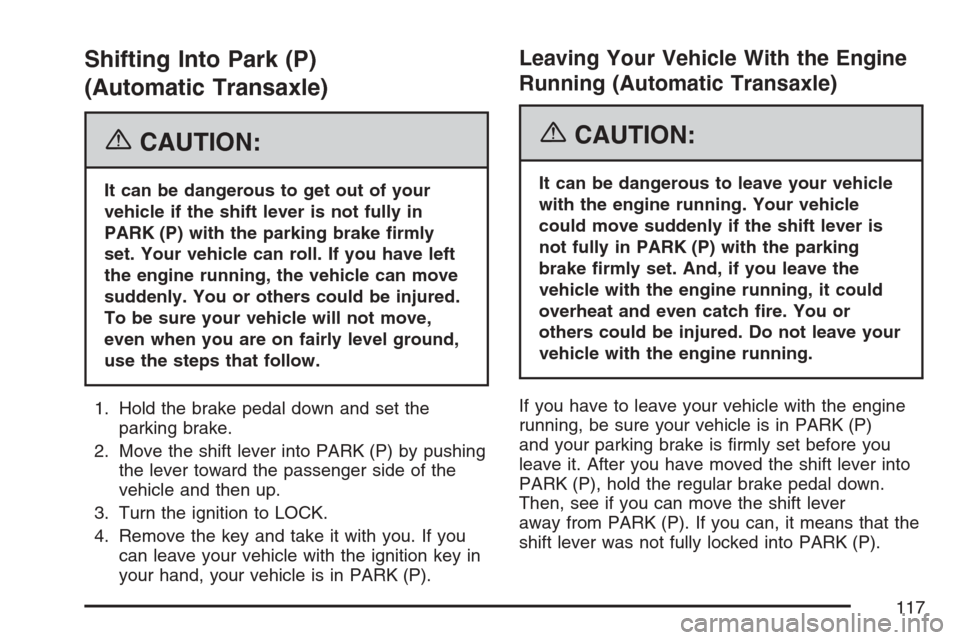
Shifting Into Park (P)
(Automatic Transaxle)
{CAUTION:
It can be dangerous to get out of your
vehicle if the shift lever is not fully in
PARK (P) with the parking brake �rmly
set. Your vehicle can roll. If you have left
the engine running, the vehicle can move
suddenly. You or others could be injured.
To be sure your vehicle will not move,
even when you are on fairly level ground,
use the steps that follow.
1. Hold the brake pedal down and set the
parking brake.
2. Move the shift lever into PARK (P) by pushing
the lever toward the passenger side of the
vehicle and then up.
3. Turn the ignition to LOCK.
4. Remove the key and take it with you. If you
can leave your vehicle with the ignition key in
your hand, your vehicle is in PARK (P).
Leaving Your Vehicle With the Engine
Running (Automatic Transaxle)
{CAUTION:
It can be dangerous to leave your vehicle
with the engine running. Your vehicle
could move suddenly if the shift lever is
not fully in PARK (P) with the parking
brake �rmly set. And, if you leave the
vehicle with the engine running, it could
overheat and even catch �re. You or
others could be injured. Do not leave your
vehicle with the engine running.
If you have to leave your vehicle with the engine
running, be sure your vehicle is in PARK (P)
and your parking brake is firmly set before you
leave it. After you have moved the shift lever into
PARK (P), hold the regular brake pedal down.
Then, see if you can move the shift lever
away from PARK (P). If you can, it means that the
shift lever was not fully locked into PARK (P).
117
Page 118 of 422
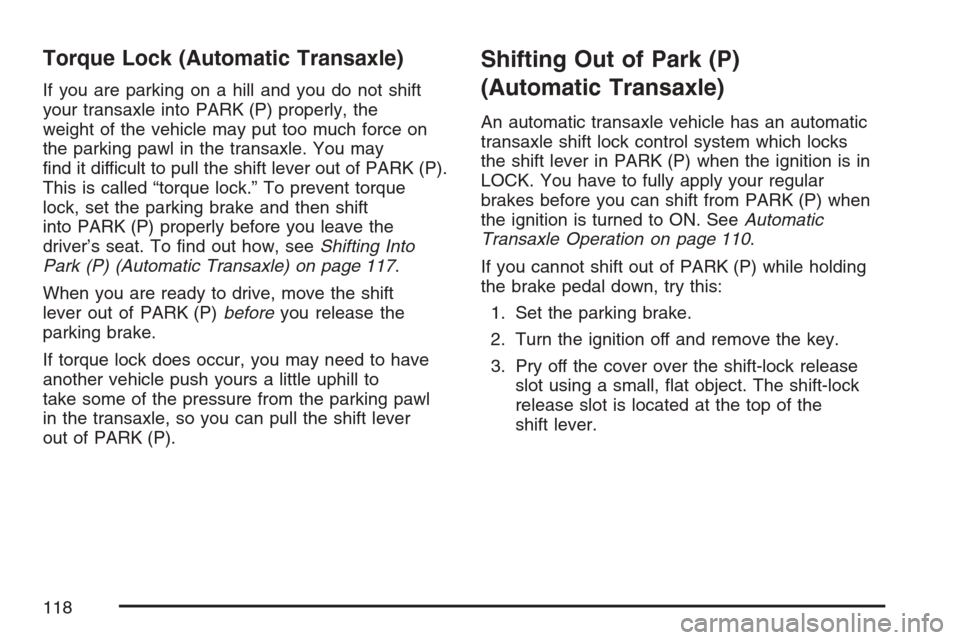
Torque Lock (Automatic Transaxle)
If you are parking on a hill and you do not shift
your transaxle into PARK (P) properly, the
weight of the vehicle may put too much force on
the parking pawl in the transaxle. You may
find it difficult to pull the shift lever out of PARK (P).
This is called “torque lock.” To prevent torque
lock, set the parking brake and then shift
into PARK (P) properly before you leave the
driver’s seat. To find out how, seeShifting Into
Park (P) (Automatic Transaxle) on page 117.
When you are ready to drive, move the shift
lever out of PARK (P)beforeyou release the
parking brake.
If torque lock does occur, you may need to have
another vehicle push yours a little uphill to
take some of the pressure from the parking pawl
in the transaxle, so you can pull the shift lever
out of PARK (P).
Shifting Out of Park (P)
(Automatic Transaxle)
An automatic transaxle vehicle has an automatic
transaxle shift lock control system which locks
the shift lever in PARK (P) when the ignition is in
LOCK. You have to fully apply your regular
brakes before you can shift from PARK (P) when
the ignition is turned to ON. SeeAutomatic
Transaxle Operation on page 110.
If you cannot shift out of PARK (P) while holding
the brake pedal down, try this:
1. Set the parking brake.
2. Turn the ignition off and remove the key.
3. Pry off the cover over the shift-lock release
slot using a small, flat object. The shift-lock
release slot is located at the top of the
shift lever.
118
Page 119 of 422
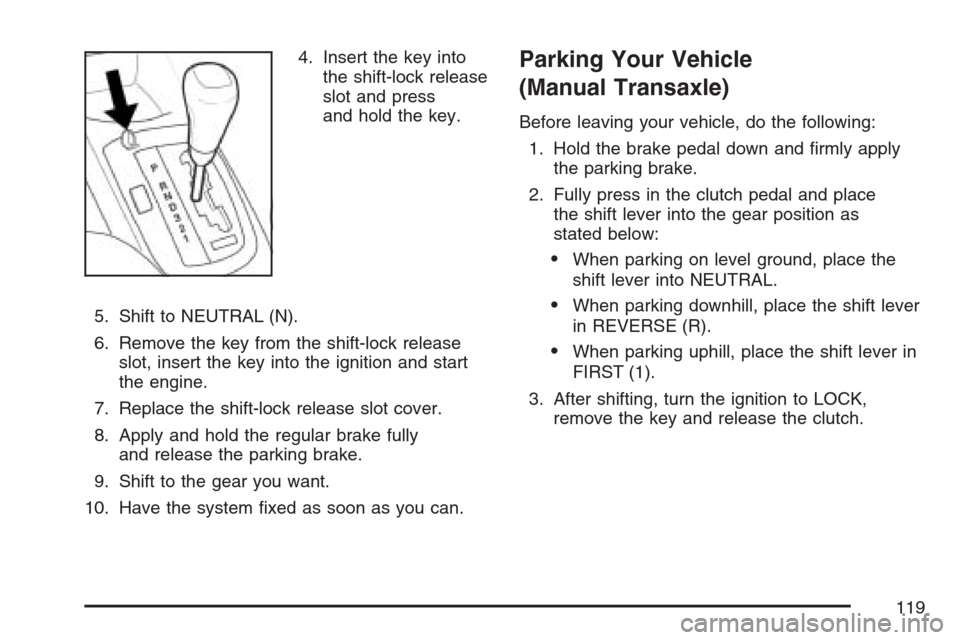
4. Insert the key into
the shift-lock release
slot and press
and hold the key.
5. Shift to NEUTRAL (N).
6. Remove the key from the shift-lock release
slot, insert the key into the ignition and start
the engine.
7. Replace the shift-lock release slot cover.
8. Apply and hold the regular brake fully
and release the parking brake.
9. Shift to the gear you want.
10. Have the system fixed as soon as you can.Parking Your Vehicle
(Manual Transaxle)
Before leaving your vehicle, do the following:
1. Hold the brake pedal down and firmly apply
the parking brake.
2. Fully press in the clutch pedal and place
the shift lever into the gear position as
stated below:
•When parking on level ground, place the
shift lever into NEUTRAL.
•When parking downhill, place the shift lever
in REVERSE (R).
•When parking uphill, place the shift lever in
FIRST (1).
3. After shifting, turn the ignition to LOCK,
remove the key and release the clutch.
119
Page 120 of 422

Parking Over Things That Burn
{CAUTION:
Things that can burn could touch hot
exhaust parts under your vehicle and
ignite. Do not park over papers, leaves,
dry grass, or other things that can burn.
120